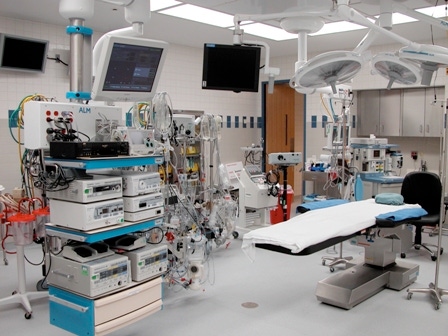Power to the Medical Device Electronics
November 9, 2010

A typical backup power system was not good enough for Joe Middleton, the forward-thinking vice president of Bassett Healthcare in upstate New York. "Not only has healthcare technology become more and more sophisticated, but the continuous delivery of electronic medical information has become critical," says Middleton.
BassetOR |
While the original power control system took care of basic life/safety needs, the recent upgrade was based on Bassett's managerial decision to better serve its patients. These days, Middleton says, the loss of power to an ever-growing number of modern diagnostic and treatment devices is not acceptable. Likewise, the loss of computer access to patient drug histories, digital radiology films, and other electronic records would be a serious setback for doctors, nurses and, ultimately, patients. "A reliable power system really needs to be a bottom-line calculation," he adds. "Unfortunately, most healthcare facilities have not realized this yet."
Bassett operates a teaching hospital (the 180-bed Mary Imogene Bassett Hospital in Cooperstown), a research institute, and clinics serving eight counties. The company employs 2,800 people and sees about 1,000 outpatients a day on top of regular admissions. While management's first concern is how to provide the best patient care, reliable backup power has a fiscal benefit as well. Middleton estimates the loss of power for eight hours would amount to a revenue loss of $1,000,000.
Thanks to two extra oil-powered generators and state-of-the-art switchgear designed and built by Russelectric Inc., of Hingham, MA, the network's backup power system goes far beyond mandated life/safety loads, exceeding the capabilities of most other hospitals.
Designed to meet NFPA Code
Bassett Healthcare's emergency power system is programmed for two stages of load pickups. When the normal utility feed is lost, Russelectric switchgear transfers critical life/safety loads (including minimal lighting and the HVAC system) to three older 900kW, 480V gensets. This is as far as a typical hospital emergency power system goes. But if the outage continues for five minutes, two newer 2mW, 12.47kV gensets kick in, picking up all loads and thus restoring full power to the hospital and 15 other buildings.
BassetPower |
Full power makes a big difference. The National Fire Protection Association's National Electrical Code says only a certain percentage of electrical receptacles (outlets) in an operating room (OR) must be on emergency power, not all of them. "
You can't count on two hands the number of electrical devices in our cardiovascular OR," says Middleton. So at Bassett, five minutes after the utility feed is lost, all receptacles are live again. At that point, Bassett facilities are energy independent, generating all their own primary power. The system can back-feed and feed around any fault on the campus. When the outage is over, the system gradually retransfers all loads to the utility.
A separate backup system ensures seamless power to Bassett's data center, with no delays or interruptions whatsoever. In addition, every outlying clinic has its own Russelectric automatic transfer switch.
BassettSwitchGear |
Generating Power and Money
The switchgear can also be programmed for baseload peak-shaving. Due to an agreement between Bassett Healthcare and the regional power company, Bassett's backup power system pays for itself over time. An "interruptible power contract" gives the utility permission to drop Bassett from the regional electrical grid (with advance notice) during periods of peak demand. In return, the utility pays Bassett-at a rate much higher than what Bassett pays for its normal feed-for every megawatt Bassett generates while off-line. Bassett also has the capacity to export power to the grid.
"It's great for us," says Middleton. "We're off the grid for a few hundred hours a year, mostly in the summertime, when the power we generate is of higher quality than what we get from the utility. Our power is rock-solid, with stable frequency and voltage. But on the grid, with all the air-conditioning demands, we see large switching transients as new power sources are switched in and out."
John A. Meuleman is vice president, sales & marketing, Russelectric
About the Author(s)
You May Also Like








